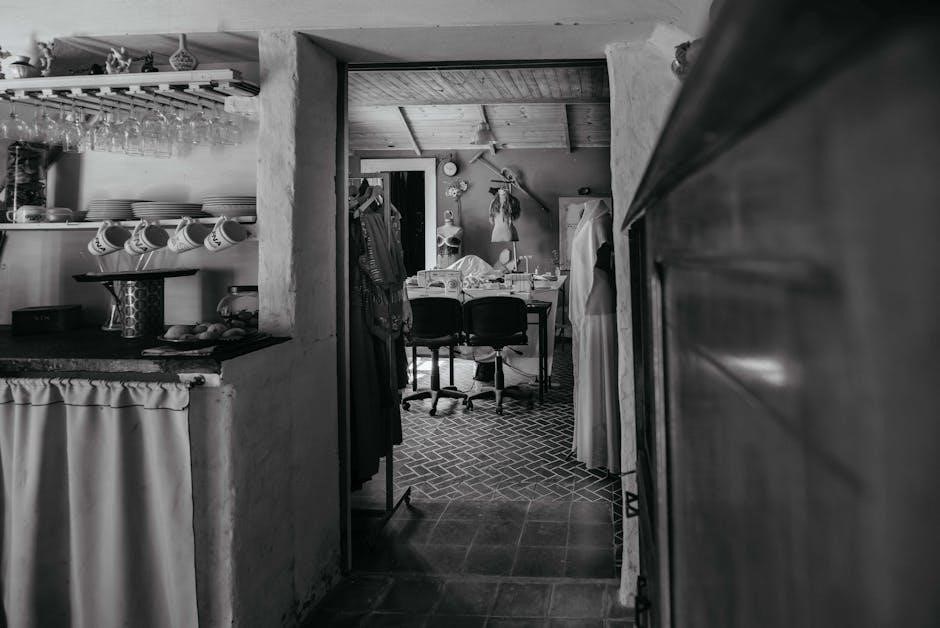Women’s PDF Sewing Patterns: A Comprehensive Guide
Unleash your inner designer with women’s PDF sewing patterns! From dresses to tops‚ find free and stylish patterns to print at home. Explore beginner-friendly options and trendy designs for a custom wardrobe creation today!
Welcome to the exciting world of women’s PDF sewing patterns! In today’s creative landscape‚ these digital blueprints have revolutionized how sewists of all levels approach garment creation. Gone are the days of solely relying on expensive‚ store-bought paper patterns that may not perfectly match your vision or body type. PDF sewing patterns offer a convenient‚ cost-effective‚ and customizable alternative‚ empowering you to craft a wardrobe that truly reflects your personal style.
This comprehensive guide will delve into the numerous benefits of using PDF sewing patterns‚ from their accessibility and affordability to the vast array of designs available online. Whether you’re a seasoned seamstress or just beginning your sewing journey‚ you’ll discover how these patterns can unlock a world of possibilities. We’ll explore where to find free and premium PDF patterns‚ discuss the advantages of digital formats‚ and provide practical tips for printing‚ assembling‚ and adjusting patterns for a perfect fit.

Imagine having access to a limitless library of designs‚ from classic wardrobe staples to trendy‚ fashion-forward pieces‚ all available at your fingertips. With PDF sewing patterns‚ this dream becomes a reality. You can browse a diverse range of styles‚ download the patterns you love‚ and start sewing whenever inspiration strikes. Plus‚ the digital format allows you to easily modify patterns to suit your unique measurements and preferences‚ ensuring a garment that fits you flawlessly.
Moreover‚ PDF sewing patterns are incredibly versatile. They can be used to create a wide variety of garments‚ including dresses‚ skirts‚ blouses‚ pants‚ jackets‚ and more. Whether you’re looking to sew a simple sundress for summer‚ a cozy sweater for winter‚ or a sophisticated blazer for work‚ you’ll find a PDF pattern to match your needs. And with the ability to print patterns at home‚ you can avoid the hassle of traveling to a fabric store and waiting in line.
In the following sections‚ we’ll explore the best resources for finding free women’s PDF sewing patterns‚ discuss the advantages of using these patterns‚ and provide practical tips for printing and assembling them. We’ll also address common fit and quality control issues and offer guidance on how to choose beginner-friendly patterns. So‚ get ready to embark on a sewing adventure and discover the endless possibilities of women’s PDF sewing patterns!

Where to Find Free Women’s PDF Sewing Patterns
One of the most appealing aspects of women’s PDF sewing patterns is the abundance of free options available online. For budget-conscious sewists or those just starting out‚ these free patterns provide a fantastic way to explore different styles and techniques without breaking the bank. However‚ with so many resources available‚ it can be challenging to know where to begin your search. This section will guide you through some of the best websites and online communities offering free women’s PDF sewing patterns.
Several reputable fabric stores and sewing blogs offer a selection of free patterns as a way to attract new customers and showcase their expertise. These patterns are often well-designed and come with clear instructions‚ making them ideal for beginners. Some popular options include Mood Fabrics‚ known for their stylish and on-trend designs; fabric.com‚ which offers a variety of free patterns from different designers; and fabrics-store.com‚ specializing in linen fabrics and offering free patterns for linen garments.
In addition to fabric stores‚ numerous independent sewing blogs and pattern designers offer free PDF patterns on their websites. These patterns often reflect the designer’s unique style and aesthetic‚ providing a diverse range of options to choose from. Some notable examples include Peppermint Magazine‚ which collaborates with independent designers to create free‚ sustainable sewing patterns; Fibre Mood‚ a European sewing magazine that offers a selection of free patterns on its website; and BurdaStyle (Russia)‚ which provides a vast collection of free patterns in various languages.
Online sewing communities and forums are another great resource for finding free PDF patterns. These communities often have dedicated sections where members share patterns they have created or found online. You can also find helpful tips and advice from experienced sewists who have used these patterns before. Some popular sewing communities include Reddit’s r/freepatterns and various Facebook groups dedicated to sewing and pattern sharing.
When searching for free PDF sewing patterns‚ it’s essential to consider the quality and reliability of the source; Look for patterns that come with clear instructions‚ detailed diagrams‚ and size charts. It’s also helpful to read reviews or comments from other sewists who have used the pattern before to get an idea of its accuracy and ease of use. While free patterns can be a great resource‚ remember that they may not always be as professionally graded or tested as paid patterns. However‚ with careful research and a bit of patience‚ you can find some fantastic free patterns that will help you expand your sewing skills and create a beautiful wardrobe.

Popular Websites Offering Free Patterns
The internet is a treasure trove when it comes to finding free women’s PDF sewing patterns. However‚ navigating this vast landscape can be overwhelming. To streamline your search‚ let’s highlight some of the most popular and reliable websites that consistently offer high-quality free patterns. These platforms cater to various skill levels and styles‚ ensuring there’s something for every sewist.
Mood Fabrics: Renowned for their designer fabrics‚ Mood Fabrics also boasts an impressive collection of free sewing patterns for both men and women. Their patterns are often inspired by high-fashion trends‚ allowing you to create stylish and contemporary garments. The patterns are well-drafted and come with detailed instructions‚ making them suitable for intermediate to advanced sewists. However‚ even beginners can find simpler projects to start with.
Peppermint Magazine: This Australian magazine is dedicated to sustainable and ethical fashion. They collaborate with independent designers to create free‚ downloadable sewing patterns that are both stylish and environmentally conscious. Their patterns often feature classic designs with a modern twist‚ and they are committed to providing clear and easy-to-follow instructions.
Fibre Mood: A European sewing magazine with a strong online presence‚ Fibre Mood offers a selection of free PDF sewing patterns on their website. Their patterns are known for their trendy and fashion-forward designs‚ catering to sewists who want to create garments that are on the cutting edge of style. While some patterns may be more challenging‚ they offer a great opportunity to expand your sewing skills.
BurdaStyle (Russia): Although the website is in Russian‚ BurdaStyle’s Russian site offers a vast collection of free sewing patterns. Don’t let the language barrier deter you; many patterns come with visual instructions and diagrams that are easy to understand. With a little patience and the help of online translation tools‚ you can access a wealth of free pattern options.
AllFreeSewing.com: This website curates free sewing patterns from various sources across the web. They offer a wide variety of patterns for women’s clothing‚ accessories‚ and home decor. This is a great place to start your search if you’re looking for a specific type of project or want to browse a diverse selection of patterns.
When exploring these websites‚ be sure to carefully review the pattern instructions and size charts before you begin. It’s also helpful to read reviews or comments from other sewists who have used the pattern before to get an idea of its accuracy and ease of use. With a little research and experimentation‚ you can find some fantastic free patterns on these popular websites that will help you create a beautiful and unique wardrobe.
Advantages of Using PDF Sewing Patterns
In the world of sewing‚ PDF patterns have revolutionized the way we access and utilize sewing patterns. Ditching the traditional paper patterns‚ PDF patterns offer a plethora of advantages that cater to both beginner and experienced sewists. From instant access to cost-effectiveness and convenient storage‚ let’s delve into the numerous benefits of embracing PDF sewing patterns for your next project.
Instant Accessibility: One of the most significant advantages of PDF patterns is their immediate availability. Unlike traditional patterns that require a trip to the store or waiting for shipping‚ PDF patterns can be downloaded instantly from the comfort of your own home. This allows you to start your project without delay‚ making it ideal for those spontaneous sewing urges or last-minute creations.
Cost-Effectiveness: PDF patterns often come at a lower price point compared to their paper counterparts. Many designers and independent pattern companies offer PDF versions of their patterns at a reduced cost. Additionally‚ the availability of free PDF patterns online provides an even more budget-friendly option for sewists looking to expand their pattern collection without breaking the bank.
Print-at-Home Convenience: PDF patterns are designed to be printed on standard home printers using letter or A4 size paper. This eliminates the need for specialized printing equipment or services. Simply download the pattern‚ print the pages‚ and assemble them according to the instructions. This convenience allows you to work on your sewing projects at your own pace and on your own schedule.
Size Customization: Many PDF patterns offer layered sizing‚ which allows you to print only the size you need. This eliminates the clutter of multiple size lines on the pattern pieces and makes it easier to cut out the correct size. Additionally‚ some PDF patterns include options for customizing the fit‚ such as adjusting the length or adding ease‚ ensuring a perfect fit for your unique body shape.
Easy Storage and Organization: Unlike bulky paper patterns that can take up valuable storage space‚ PDF patterns can be stored digitally on your computer or in the cloud. This makes it easy to organize and access your pattern collection. You can create folders for different types of garments‚ designers‚ or projects‚ ensuring that you can quickly find the pattern you need when inspiration strikes.
Durability and Reusability: Once you’ve printed and assembled a PDF pattern‚ you can trace it onto durable paper or fabric to create a reusable pattern. This allows you to make the same garment multiple times without having to reprint the pattern each time. Additionally‚ if a pattern piece gets damaged or lost‚ you can simply reprint it from the PDF file.
Environmentally Friendly: By choosing PDF patterns over traditional paper patterns‚ you’re contributing to a more sustainable sewing practice. PDF patterns reduce the need for paper production‚ transportation‚ and storage‚ minimizing your environmental impact.
Tips for Printing and Assembling PDF Patterns
Printing and assembling PDF sewing patterns can seem daunting at first‚ but with a few helpful tips and tricks‚ the process can become smooth and efficient. Ensuring accurate printing and careful assembly is crucial for achieving a well-fitting and professional-looking finished garment. Here’s a comprehensive guide to help you navigate the world of PDF pattern printing and assembly:
Software and Settings:
- Adobe Acrobat Reader: Use the latest version of Adobe Acrobat Reader to open and print your PDF patterns. It’s a free and reliable software that ensures proper scaling and printing.
- Actual Size: In the print settings‚ always select “Actual Size” or “100% scaling.” Avoid options like “Fit to Page” or “Shrink to Fit‚” as they can distort the pattern’s dimensions.
- Print Range: If the pattern includes multiple sizes‚ utilize the layered feature (if available) to print only the size you need. This saves ink and paper.
- Test Square: Before printing the entire pattern‚ print the page with the test square. Measure the printed square to ensure it matches the indicated dimensions (usually 1 inch or 2.5 cm). Adjust your printer settings if necessary.

Printing Process:
- Paper Quality: Use standard printer paper (20 lb or 75 gsm) for printing. Avoid using glossy or photo paper‚ as it can be difficult to tape together.
- Ink Levels: Ensure your printer has sufficient ink to prevent faded or incomplete prints.
- Print One Page First: Before printing the entire pattern‚ print just one page to check the alignment and print quality.
- Organize Pages: As the pages print‚ keep them organized in the correct order. Most patterns include page numbers or a layout diagram to guide you.
Assembling the Pattern:
- Trim Margins: Carefully trim the margins of each page along the indicated lines. Some patterns have overlapping margins that need to be removed.
- Align and Tape: Align the pages according to the layout diagram‚ matching the registration marks or alignment lines. Use clear tape to secure the pages together‚ ensuring the edges are flush.
- Overlap (If Applicable): If the pattern uses an overlap method‚ carefully overlap the pages as indicated and tape them securely.
- Pattern Markings: Once assembled‚ carefully review the pattern for all markings‚ including grainlines‚ notches‚ darts‚ and seam allowances.
Pattern Adjustments:
- Tissue Paper: Consider tracing the assembled pattern onto tissue paper to preserve the original pattern and make alterations easier.
- Muslin Mock-up: Before cutting into your final fabric‚ create a muslin mock-up of the garment to test the fit and make any necessary adjustments.
Storage:
- Roll or Fold: Store your assembled patterns by rolling them up or folding them neatly. Avoid creasing the pattern pieces excessively.
- Pattern Envelope: Place the pattern in a large envelope or plastic bag to protect it from dust and damage.
By following these tips‚ you can confidently print and assemble PDF sewing patterns‚ setting the stage for successful and enjoyable sewing projects. Remember to take your time‚ double-check your work‚ and enjoy the process of bringing your creative visions to life!
Embracing the World of PDF Sewing Patterns
Addressing Fit and Quality Control Issues
While PDF sewing patterns offer convenience and accessibility‚ addressing fit and quality control issues is crucial for achieving successful and satisfying sewing results. Fit problems and inconsistencies in pattern quality can arise from various factors‚ including printing inaccuracies‚ pattern drafting errors‚ and variations in body measurements. Here’s a comprehensive guide to help you identify and resolve these issues:
Identifying Fit Issues:
- Muslin Mock-up: Always create a muslin mock-up before cutting into your final fabric. This allows you to assess the fit and make adjustments without risking your precious materials.
- Common Fit Problems: Be aware of common fit issues such as gaping necklines‚ tight shoulders‚ pulling across the bust‚ excess fabric at the waist‚ and tight hips.
- Body Measurements: Take accurate body measurements and compare them to the pattern’s size chart. Choose the size that corresponds most closely to your measurements.
- Ease: Understand the concept of ease‚ which is the amount of extra fabric added to a garment for comfort and movement. Check the pattern’s description for the intended ease.
Resolving Fit Issues:
- Grading Between Sizes: If your measurements fall between sizes‚ grade between them. For example‚ you might use a smaller size for the shoulders and a larger size for the bust.
- Adjusting Pattern Pieces: Learn how to make common pattern adjustments such as shortening or lengthening the bodice‚ adjusting the bust dart‚ and adding or removing width at the hips.
- Full Bust Adjustment (FBA): If you have a larger bust‚ perform a full bust adjustment (FBA) to add extra fabric to the bust area.
- Small Bust Adjustment (SBA): If you have a smaller bust‚ perform a small bust adjustment (SBA) to remove excess fabric from the bust area.
- Shoulder Adjustments: Adjust the shoulder slope to match your own shoulder slope. This can prevent gaping necklines or tight shoulders.
Addressing Quality Control Issues:
- Pattern Accuracy: Check the pattern for accuracy by comparing the measurements of key pattern pieces to the indicated dimensions.
- Grainlines: Ensure that the grainlines are clearly marked and aligned correctly.
- Notches and Markings: Verify that all notches and markings are present and accurate. These are essential for aligning pattern pieces during sewing.
- Seam Allowances: Check the seam allowances to ensure they are consistent throughout the pattern.
- Pattern Instructions: Read the pattern instructions carefully and look for any inconsistencies or errors.
Seeking Help and Resources:
- Online Communities: Join online sewing communities and forums to ask for advice and share your experiences.
- Sewing Blogs and Tutorials: Consult sewing blogs and tutorials for detailed instructions on pattern adjustments and fit solutions.
- Professional Fitters: Consider consulting a professional fitter for personalized advice and guidance.
By proactively addressing fit and quality control issues‚ you can ensure that your PDF sewing projects result in well-fitting‚ high-quality garments that you’ll be proud to wear. Remember to be patient‚ persistent‚ and willing to experiment until you achieve the perfect fit.





